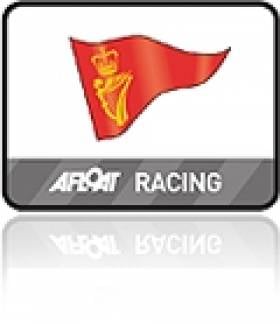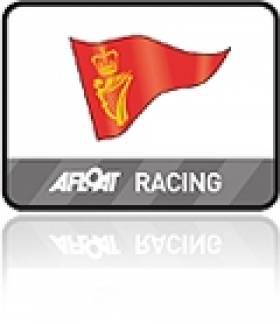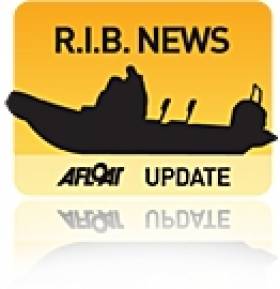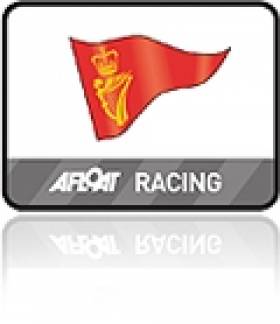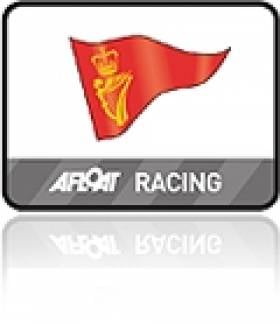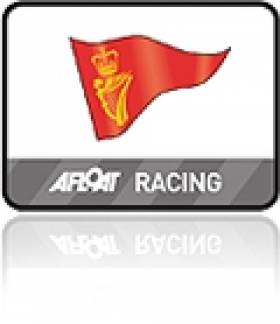Displaying items by tag: Royal Cork
Brisk Sailing for Royal Cork's Naval Race (Photos here)
There was a great sailing breeze for today's Royal Cork Naval Race in Cork harbour and the appearance of the Navy's own Sail Training Yacht Creidne added to the occasion at Haulbowline writes Claire Bateman. Scroll down for photos.
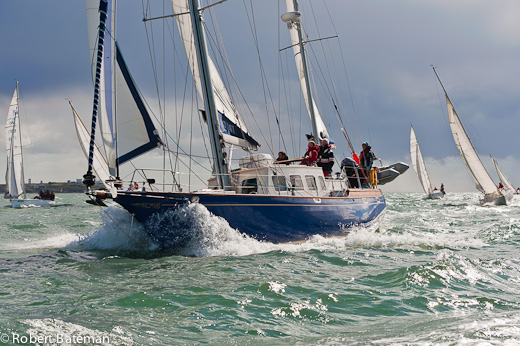
The Defence Forces STY Creidne shows her pace in Cork Harbour in today's Royal Cork Yacht Club Naval Race. Photo: Bob Bateman. More photos below
The second fleet to start, comprising of Classes Three, Four and White Sail Class that included many Class One boats, were given a reaching start in the harbour into Corkbeg, a beat across to Cage, a run back to Corkbeg, a reach in the harbour and a beat to the finish before arriving at the Naval Base.
For this scribe the highlight of the event was to watch the Creidne with her gleaming blue topsides joust with Táilte. Creidne being a bigger boat with a longer waterline and ketch rig had the legs on Táilte on the reach but Táilte was pointing higher on the beat, had more manoeuverability and got ahead at Cage. On the reach back to Corkbeg Creidne again showed her speed to round Corkbeg just behind Táilte. It was great sailing and well done to both crews and their helmsMeanwhile in Class Three the Jimmy Nyhan/Maritta Buwalda Outrigger was making all the running and were using their asymmetric spinnaker to good effect and despite the best efforts of the J24 and the Impalas they couldn't catch them.
The conditions were such that the white sail boats were having a ball but as the fleet were rounding the Spit Bank a squall struck and took away some of the pleasure. However, it was soon to clear before the merry band arrived at the Naval Base to enjoy well earned and most generous hospitality provided by the Naval Service.
Royal Cork Move up to Seventh in New York
Royal Cork Yacht Club is seventh overall after scoring an impressive third place in yesterday's race nine of the New York Invitational Cup. The Anthony O'Leary skippered yacht moved from tenth to seventh after scores of 3 and 12 in the penultimate day of the competition yesterday. The Crosshaven crew is five points behind sixth place Japan, a team that have consistently held an advantage over the Irish crew this week.
The New York Chamber of Commerce could not have arranged a more spectacular day for the 22 competing yacht club teams, representing 16 nations from six continents, than what was delivered today after a cold front that passed through the area overnight left behind a classic New England fall day to tantalize competitors at the 2011 New York Yacht Club Invitational Cup presented by Rolex. And after sailing eight races over three days on courses set north of Newport's Pell Bridge, with the breeze from the north-northwest, and an ebb tide, the race committee made the decision to send the competitors out of the now-familiar Narragansett Bay to Rhode Island Sound for two races on the penultimate day of the series.

Royal Cork YC's entry in the New York Cup skippered by Anthony O'Leary with tactics from son Nicholas Photo: Rolex/Kurt Arrigo
Remarkably, the first race of the day saw yet another yacht club team winning a race. Eastern Yacht Club became the ninth race winner, in nine races, when they took over the lead early in the race and held it all the way to the finish line.
"It was a good one," said Bill Lynn, helm of the Eastern Yacht Club team of the race as he explained that the EYC sailors liked the conditions today. "I think we're fast , but I don't think we're the fastest boat here, so I think getting out into some shifty, variable breeze with not perfectly flat water, suits our style in these boats a little better. We finally got a great start, which is kind of nice. It was probably our best start of the series so far, and then we just were patient. When we came off the windward end [of the starting line] and tacked onto port there were an awful lot of boats on port way up inside us. It looked grim there for a while. But we were going to stick to our guns and wait it out. And we did, and the righty finally came in at the end and got us around the mark in third and then after that it was playing the shifts [to stay at the top]."
When Lynn's team got through the first gate, they split with the Royal Yacht Squadron. "Fortunately we sent them around the wrong gate and we went around the right gate. When the breeze shifted back left we were crossing them. After we went through the gate and started going back upwind it got super windy, our gage was showing low 20s, and it stayed that way for the rest of the race. When it [the breeze] came smoking back in half-way through, that wasn't in anybody's forecast."
Lynn went on to explain that in a northwest breeze, you have to sail your own race and not worry too much about the other boats. "You almost have to pretend there are no other boats on the course. It's not about winning every race in a northwester, its about not blowing one." For race two, Lynn characterized Eastern's start as good, but in the wrong place on the line. They would go on to finish sixth, and now have 82 points on the scoreboard to stand fifth overall, while tied on points with Newport Harbor Yacht Club which is currently fourth.
For the second day in a row, the final race of the day has been won by the Clube Naval de Cascais (CNC) from Portugal, making them the first team in the 10 races to repeat as a winner. At the helm of CNC is Patrick Monteiro de Barros, whose varied sailing resume includes representing his country at the Olympic Games (twice), as well as circumnavigating the globe (twice). CNC placed 21st in the earlier race today, and with 128 points lies 16th overall.
It would certainly seem that the artic air from home brought additional good fortune for Royal Canadian Yacht Club (RCYC), as they maintained their grip on the top-position in the overall standings. With finishes of 6-11 today, they not only have 46 points but also have increased the spread to 10 points over New York Yacht Club which has 56.
Annapolis Yacht Club has moved up to third overall on 68 points after finishing 4-2 today. Tactician John Torgerson compared the flukey conditions the AYC team is used to in Annapolis with what they saw today on Rhode Island Sound. "It was super-shifty for a while and we like that," said Torgerson. "We had a good idea of what we were going to do off the start and we executed it. For the first race it was light at the start. We saw as little as nine [knots] to as much as 22, it was a huge range. You just had to be able to shift gears. We have guys that are really good at figuring it out." AYC's strategy for the final day of racing is to "just go out and sail" and hope that the two teams above and below them take each other out.
The eleventh and final race of the series will be held tomorrow, Saturday, September 17, and is scheduled for 1100. It will be preceded by the fleet parading through Newport harbor at 0900, with competitors leaving NYYC's Harbour Court at approximately 0830. The winner of the 2011 New York Yacht Club Invitational Cup presented by Rolex will be confirmed at the conclusion of racing.
Cork Week 2012 Chairman Appointed
Royal Cork Yacht Club has announced Pat Lyons will chair the club's biggest sailing regatta next season. Cork Week 2012 at Crosshaven is scheduled to run from the 7th - Friday 13th July 2012 following a decison to move the date back a week to avoid a clash with the Solent's Round the Island Race. Lyons has served on Royal Cork's Club Executive for the last 4 years.
O'Leary Stays in Top Ten in New York
Anthony O'Leary's Royal Cork Yacht Club crew stay in the top ten overall after scoring two double digit results yesterday at the Rolex New York Invitational Cup. The Crosshaven crew counted a 20 and a 15 in the 22-boat fleet.
After several days of late summer breeze and sunshine, thick fog rolled into Narragansett Bay, greeting competitors of the New York Yacht Club Invitational Cup presented by Rolex and forcing a short postponement to today's racing. Twenty-two yacht club teams from 16 countries are here in Newport to contest the second edition of this biennial event.After a delay of just under an hour, the fleet were sent up Narragansett Bay, north of the Newport Bridge where the flat water and 10-knot south-southwesterly built to a perfect 12-15 knots by the afternoon.
Yesterday after six races were completed, the Royal Canadian Yacht Club team, skippered by Olympic silver medalist Terry McLaughlin, had a solid lock on the top of the leader board with a 13-point advantage over the New York Yacht Club team.
But with a fleet this deep in talent, one bad race and a double-digit advantage can be whittled down. As McLaughlin presciently said yesterday, "That can disappear in a real hurry." Meanwhile the NYYC team, led by Ken Colburn with Phil Lotz, the 2009 Invitational Cup winner, as tactician kept their focus with fourth and second place finishes today and closed the gap with Canada to five points.
While Lotz' recap of their races sounded pretty matter-of-fact, the American team worked hard to get a good start on the right side and found a lane there that enabled them to tack when they wanted. Lotz said, "We were lucky enough that the right paid off and we kept our nose clean and got around the course. We were fortunate enough to get to the right side early." But with three more races planned, he was quick to add, "I think with a shifty nor'west tomorrow, it's anybody's game. Bad races are just as possible as good races. If it's more breeze and shifty, it's going to be a boat handling issue, and keeping your head out of the boat and seeing where the shifts are, and making sure you're going in the right direction."
Newport Harbor Yacht Club edged past Annapolis Yacht Club today to stand in third place overall.
The group of teams with first place finishes grew today with eight unique winners over the same number of races. Two boats that had barely cracked a top ten finish prevailed today: the German team from Norddeutscher Regatta Verein and Clube Naval de Cascais from Portugal.
For Patrick de Barros' Portuguese team, it all came together on the last race where they got off the start line well-positioned, rounded the weather mark in third, and then went to the left side of the course where they got in front and held their lead. Although NYYC team threatened, CN de Cascais covered them very closely at the finish and crossed ahead. Clearly buoyed by their performance de Barros said, "We have the speed, now we start to know how the boat functions. It's a very challenging course, a good course, but challenging. It's been really fantastic, we've enjoyed every minute."
The Royal Yacht Squadron enjoyed a good bump up the standings going from 11th to seventh. Helmsman Glyn Williams explained, "I was a little disappointed after yesterday's sailing, as I didn't feel we sailed to the potential. The team had done a lot of sailing together and we were just making unforced errors early in the week. So our first race today, we got cleanly off the line. At the top mark, we did a gybe set, which was incredibly clean and put us in the hunt. I told the team this morning that yesterday Annapolis moved from tenth to third, so there're options to go up in a series like this. The crew did a great job today!"
Oliver Stanley, RYS team captain, spoke of the competition, "I think the standard of sailing is as high as you get in any amateur regatta, anywhere in the world. It's a great privilege to be here -- make one mistake and you lose six places."
Stanley was with the team at the 2009 Invitational Cup event, when the RYS finished in 16th place overall. He recalled, "Given our finish, we weren't invited back on merit. We were invited on ancestry, history and tradition. It's very important that we're invited back on merit this time. We really want to be automatically invited, to have a top five finish. We'd be over the moon with that."
Racing continues tomorrow Friday through Saturday 16 - 17 September. Tomorrow's first warning signal is scheduled for 11:00 am.
Results after 8 races:
Team - Country - Points
1. Royal Canadian, CAN, 29
2. New York, USA, 34
3. Newport Harbor, USA, 61
4. Annapolis, USA, 63
5. Royal Hong Kong, HKG, 70
6. Eastern, USA, 76
7. Royal Yacht Squadron, GBR, 77
8. Japan, JPN, 80
9. Royal Cork, IRL, 86
10. YC Argentino, ARG, 89
11. Royal Ocean Racing Club, GBR, 91
12. CYC Australia, AUS, 95
13. NRV, GER, 99
14. Royal Norwegian, NOR, 102
15. Royal Cape, RSA, 104
16. CN de Cascais, POR, 106
17. Royal Bermuda, BER, 106
18. NJK, FIN, 112
19. Itchenor, GBR, 116
20. YC Capri, ITA, 123
21. RCN Barcelona, ESP, 148
22. YC Punta Ala, ITA, 160
The 22 entrants
By country, the roster of participating teams is: Yacht Club Argentino (ARG); Cruising Yacht Club of Australia (AUS); Royal Bermuda Yacht Club (BER); Royal Canadian Yacht Club (CAN); Royal Hong Kong Yacht Club (HKG); Real Club Nautico de Barcelona (ESP); Nyländska Jaktklubben (FIN); Itchenor Sailing Club, Royal Ocean Racing Club and Royal Yacht Squadron (GBR); Norddeutscher Regatta Verein (GER); Royal Cork Yacht Club (IRL); Yacht Club Capri and Yacht Club Punta Ala (ITA); Japan Sailing Federation (JPN); Royal Norwegian Yacht Club (NOR); Clube Naval de Cascais (POR); Royal Cape Yacht Club (RSA); Eastern Yacht Club, Annapolis Yacht Club, Newport Harbor Yacht Club and New York Yacht Club (USA).
Foynes Takes Regional RIB Title at Royal Cork
The first of three regional finals of the ISA Yachtsman Euromarine Rib Challenge 2011 was held at Royal Cork Yacht Club last Saturday and it was an exciting start to the competition.
This year the competition was designed to encourage the younger members of our boating community to take to the water in a safe, responsible and most important an enjoyable way. On registration the competition sponsor Matt McGrory who was in attendance started off proceedings in a positive and fun manner by giving each entrant a competition T Shirt and taking a team Photo. This got all teams into a fun and competitive frame of mind.

Negotiating the tasks on the Royal Cork RIB course. Photo: Matt McRory
This Regional Final saw the ISA introduce a new format for the competition. Each Team had to carry out 10 tasks in a 3 hour period. These tasks consisted of "on the water maneuvering" of their craft and some off the water activities such as "rescue line throwing, Knots and various questions on all aspects of boating".
For the 3 hour period you could feel the tension as all teams went from task to task, when the time was up ISA RDO Ciaran Murphy had the task of adding up the scores. Throughout the day the high scores in each competition differed with no Team showing dominance. In the end it was a tight affaire and the Top Six were:

RIB Competitors at Royal Cork
1st Place – Foynes 1
2nd Place – Foynes 2
3rd Place – Royal Cork Yacht Club
4th Place – Glandore Harbour Yacht Club
5th Place - Atlantic Sailing Club
6th Place – Sailing Academy of Ireland
The top four teams now qualify through to the National Final where they have a chance of winning the ISA Yachtsman euromarine Rib Challenge 2011 top prize of a Club Rib.
Cavatina Takes Win on Ringabella Course
Results Summary
1st in White Sail IRC Ian Hickey's Granada 38 "Cavatina"
1st in White Sail Echo Batt O'Leary's Sun Odyssey 36i "Sweet Dreams"
1st in Class 3 IRC Jimmy Nyhan & Maritta Buwalda's 1/4 Tonner "Outrigger"
1st in Class 3 Echo Sarah Hyde's J24 "Junebug"
1st in Class 2 IRC Ted Crosbie's X302 "No Excuse"
1st in Class 2 Echo Leonard Donnery's Nicholson 33 "No Gnomes"
1st in Class 1 IRC Kieran Twomey's Corby 38 "Gloves Off"
1st in Class 1 Echo Coleman Garvey & Martin Darrer's Projection 35 "True Penance"
O'Leary's Set for New York Show Down
Royal Cork's Anthony O'Leary returns to New York's Invitational Cup next week for another crack at the Rolex event that has attracted 22 teams.
Despite no previous experience with the Swan 42, Anthony O'Leary's team from the Royal Cork Yacht Club got off to a blazing start at the 2009 Invitational Cup, scoring a third and two firsts in the opening three races. From there the team rode a bit of a roller coaster with three more top-five finishes, a 13th, and two 17ths. The end result was fifth, a bit disappointing given the quick start, but respectable, nonetheless. More importantly, it earned O'Leary and his team a return invitation.
When racing begins on Tuesday, September 13, at the 2011 New York Yacht Club Invitational Cup presented by Rolex, most of the 22 participating yacht club teams will be fresh from racing at the peak of the sailing season in the northern hemisphere.
Last year, O'Leary was named the Afloat Irish Independent Sailor of the Year for, in part, leading the Irish team to the win at the 2010 Rolex Commodore's Cup."We will continue to sail [the Ker 39] Antix up to mid-season in handicap fleets, as our boat is similar in characteristics to the Swan 42," says O'Leary of his preparations for the Invitational Cup. "Closer to September we will focus more on one-design sailing, which is really the ultimate challenge as shown in the Invitational Cup. Apart from our not finishing on the podium, there was not a single disappointing aspect of the 2009 regatta. The entire event was a great experience, superbly organized by a wonderful club."
O'Leary was still assembling his crew, but it will surely include some family members. Son Peter O'Leary sailed in the 2008 Olympics in the Star class while Nicholas O'Leary, a three-time All-Ireland sailing champion, served as the team's tactician during the 2009 Invitational Cup.
Three teams though – the Cruising Yacht Club of Australia, Royal Cape Yacht Club and Yacht Club Argentino – which hail from below the equator, will be coming from winter to summer to race in Swan 42s for the championship title. "It is an honor for the Yacht Club Argentino (YCA) to participate this coming September," said Commodore Ricardo Galarce. "We are proud of sharing such an important regatta with well-known clubs from different parts of the world.
Besides, it is nice to share with all of them the same objective of competing with fair play and sailing which is what we love doing. We will go to New York Yacht Club's Harbour Court ready to have fun, but we will be doing our best effort to take the cup back to our beloved YCA in Buenos Aires." Galarce explained that even though it is winter in Argentina, the weather is not so cold and the sailors are used to sailing in this season. After the invitation to the event was published in the YCA magazine, any club member who wanted to join the team was encouraged to do so. A team selection was then made taking into account sailing resumes, technical skills and personalities, in order to form a complete, competitive and compatible crew.
Because there was a boat similar to the Swan 42 available for their use in Mar del Plata, the YCA team traveled 400 km to spend a weekend there performing intensive training, "with very good results and lots of learning as regards each of the crew members' functions and movements," said Galarce. "We then carried on our training in Buenos Aires, always trying to sail in boats similar to the Swan 42, which we know is an excellent boat, which demands a lot from its crew." With only two of the crew having previously sailed in Newport – Santiago Braun and Francisco Billoch who each sailed the Onion Patch Series in 1972 – the YCA team is studying the weather forecasts, tides and winds, in order to gain some local knowledge. And the team hopes to become familiar with the Swan 42 in the short time between their arrival and the start of the Invitational Cup. "We know it won't be an easy regatta," concluded Galarce. "We are proud of being able to sail alongside sailors who belong to the most distinguished sailing clubs in the world. We wish them all good luck, and we hope to share great fun on the water."
In Australia where the average sailing temperature for the Cruising Yacht Club of Australia's (CYCA) winter series is 20 degrees Celsius (68 Fahrenheit), sailing is a year-round activity, and all of the CYCA team members race throughout the year in various club events. Most of the CYCA crew that will travel to Rhode Island sailed together for the first time in April on the Corby 49 Vamp in the New South Wales IRC championships, finishing third overall. Vamp then finished second in Division 1 in the recently concluded CYCA Winter series. "None of us have experience in the Swan 42s although most have sailed in similarly equipped and designed yachts over a range of sizes up to the TP52 class," said David Fuller, CYCA Team Manager. "Whereas we have not had many opportunities to sail together, most of our crew have continued to sharpen their skills on other boats in the various races and regattas along the Australian coast and overseas." CYCA tactician Evan Walker is one of those who have been away from Sydney, having recently been at Weymouth, England, to coach an Elliot 6m team at the 2012 Olympic test event.
Before coming to Newport, however, Walker will be racing as tactician in the Cartagena round of the Audi MedCup with an Australian Soto 40 team. "Hopefully the week of sailing as tactician in Spain will have me hitting my straps by the time I arrive in Newport," said Walker, a CYCA Youth Academy graduate who has seen success as a match racing skipper. "I'm very excited to be competing in the Invitational Cup and I'm sure we'll have an enthusiastic team bonding session on our arrival in Newport." David Hudson, skipper of the team from the Royal Cape Yacht Club (RCYC) in South Africa was also at the Olympic test event. "Regarding our preparation for the Invitational Cup, it's obviously not as convenient for us as it would be if the event took place towards the end of our racing season," said Hudson. "However, winter training in Cape Town is perfectly feasible from a weather point of view. At 34 degrees south we have a Mediterranean climate with warm dry summers and cold wet winters, and although we have recently had some snow on the mountains just to the east of our sailing waters, Cape Town seldom gets really cold."
And while none of the RCYC team has any experience racing Swan 42s, they too have been training on a variety of boats of similar size. "We are all looking forward to the challenge," said Hudson. John Martin, RCYC's Commodore and team manager, lived on yachts from the age of eight and cut his teeth in 1971 aboard a new Swan 37 imported to South Africa specifically to do the Cape to Rio race, starting as bowman and working his way back. So it is very apt for him to be sailing a Swan 42 in this regatta, all these years later.
Not only is Martin the most famous yachtsman in South Africa but also he is well-known internationally. "Newport has great memories for me," said Martin. "During my single- and double-handed sailing career, 1981–1991, I had the honor of winning a few races, most importantly, winning the last leg of the 1986/87 BOC Singlehanded Round the World Race which finished in Newport. It is with great delight that I return with a very competent and competitive sailing team to represent the club of which I have been Commodore for the past three years."
An official practice for the 22 yacht club teams will take place on Monday, September 12, from 1300-1700, followed by the opening ceremony for the Invitational Cup. Five days of racing will ensue, with the first warning signal scheduled for 1100 each day.
The winning team will be confirmed at the conclusion of racing on Saturday, September 17. In addition to Rolex, which for 2011 and 2013 is the presenting sponsor, Sperry Top-Sider and Nautor's Swan have also returned, and are joined by Atlantis WeatherGear, as sponsors to enhance the experience of competitors as well as those who will be following the races.
The New York Yacht Club Invitational Cup presented by Rolex NYYC's Harbour Court will host 22 yacht club teams – representing 16 nations from six different continents – with racing on NYYC Swan 42s on Rhode Island Sound and Narragansett Bay from September 10-17, 2011. By country, the roster of participating teams is: Yacht Club Argentino (ARG); Cruising Yacht Club of Australia (AUS); Royal Bermuda Yacht Club (BER); Royal Canadian Yacht Club (CAN); Royal Hong Kong Yacht Club (HKG); Real Club Nautico de Barcelona (ESP); Nyländska Jaktklubben (FIN); Itchenor Sailing Club, Royal Ocean Racing Club and Royal Yacht Squadron (GBR); Norddeutscher Regatta Verein (GER); Royal Cork Yacht Club (IRL); Yacht Club Capri and Yacht Club Punta Ala (ITA); Japan Sailing Federation (JPN); Royal Norwegian Yacht Club (NOR); Clube Naval de Cascais (POR); Royal Cape Yacht Club (RSA); and Eastern Yacht Club (Marblehead, Mass.); Annapolis Yacht Club (Annapolis, Md.); Newport Harbor Yacht Club (Newport Beach, Calif.); and New York Yacht Club (Newport, R.I.) from the USA.
Royal Cork Celebrates 2011 with 'At Home' Regatta
Royal Cork Yacht Club Admiral Paddy McGlade presided over the Crosshaven Club's annual 'At Home' Regatta yesterday, an event dedicated to families with entertainment this year from the Carrigaline Pipe Band. Among a number of fun events such as Tug 'o' war, the highlight was the intense competition on the water for the Optimist parents race. All the action on the Afloat gallery by Bob Bateman here.
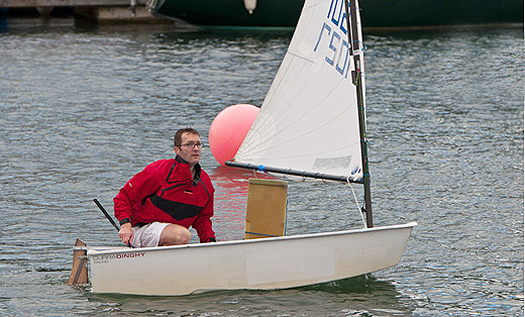
Royal Cork's Patrick Coveney in calm seas for the 'At Home' Optimist race
Cork Week Changes Dates for 2012
Next year's Cork Week regatta at Royal Cork Yacht Club, one of Ireland's biggest sailing events, has changed dates from 30th June – Friday 6th July to 7th-13th July 2012 following consultation with both local and overseas participants.
The decision was made to change the date of the biennial event because it would have otherwise have clashed with Britain's Round the Island Race on June 30th.
D-Tox on Form in O'Leary Insurance League
Results Summary:
1st in White Sail IRC Micheal Lynch's Sun Odyssey 32i "Lady T"
1st in White Sail Echo Micheal Lynch's Sun Odyssey 32i "Lady T"
1st in Class 3 IRC Jimmy Nyhan & Maritta Buwalda's 1/4 Tonner "Outrigger"
1st in Class 3 Echo Tom & Cormac MacSweeney's Sigma 33 "Seascapes"
1st in Class 2 IRC Paul & Deirdre Tingle's First 31.7 "Alpaca"
1st in Class 2 Echo Leonard Donnery's Nicholson 33 "No Gnomes"
1st in Class 1 IRC Donal O'Leary's X35 "D-Tox"
1st in Class 1 Echo Frank Doyle's A35 "Endgame"


























